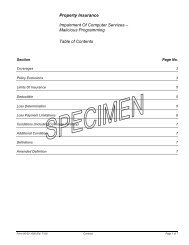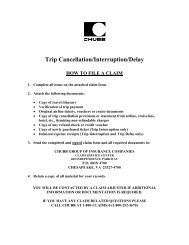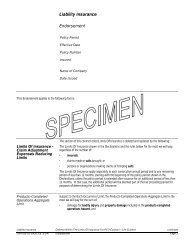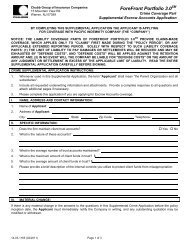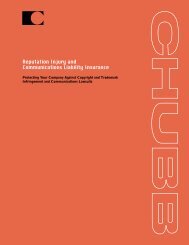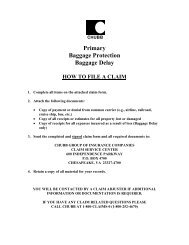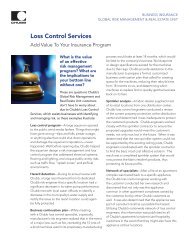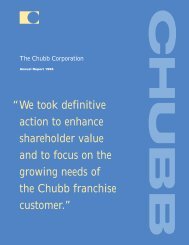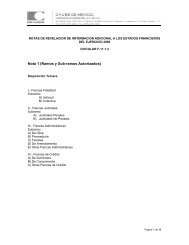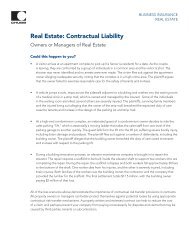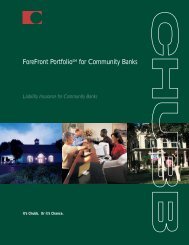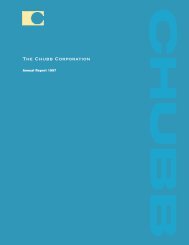Annual Report 2005 - Chubb Group of Insurance Companies
Annual Report 2005 - Chubb Group of Insurance Companies
Annual Report 2005 - Chubb Group of Insurance Companies
Create successful ePaper yourself
Turn your PDF publications into a flip-book with our unique Google optimized e-Paper software.
coverage and expanded theories <strong>of</strong> liability in the past and the possibilities <strong>of</strong> similar interpretations in<br />
the future, particularly as they relate to asbestos claims and, to a lesser extent, toxic waste claims, it is<br />
possible that management's estimate <strong>of</strong> the ultimate liability for losses that had occurred as <strong>of</strong><br />
December 31, <strong>2005</strong> may increase in future periods. Such increases in estimates could have a material<br />
adverse eÅect on the Corporation's future operating results. However, management does not expect<br />
that any such increases would have a material adverse eÅect on the Corporation's consolidated<br />
Ñnancial condition or liquidity.<br />
Estimates and Uncertainties<br />
The process <strong>of</strong> establishing loss reserves is complex and imprecise as it must take into consideration<br />
many variables that are subject to the outcome <strong>of</strong> future events. As a result, informed subjective<br />
estimates and judgments as to our ultimate exposure to losses are an integral component <strong>of</strong> our loss<br />
reserving process.<br />
Due to the inherent complexity <strong>of</strong> the loss reserving process and the potential variability <strong>of</strong> the<br />
assumptions used, the actual emergence <strong>of</strong> losses could vary, perhaps substantially, from the estimate<br />
<strong>of</strong> losses included in our Ñnancial statements, particularly when settlements may not occur until well<br />
into the future. A relatively small percentage change in the estimate <strong>of</strong> net loss reserves would have a<br />
material eÅect on the Corporation's operating results. For example, a hypothetical 1% increase in net<br />
loss reserves at December 31, <strong>2005</strong> would have resulted in a pre-tax charge <strong>of</strong> approximately<br />
$190 million.<br />
Our loss reserves include amounts related to short tail and long tail classes <strong>of</strong> business. ""Tail''<br />
refers to the time period between the occurrence <strong>of</strong> a loss and the settlement <strong>of</strong> the claim. The longer<br />
the time span between the incidence <strong>of</strong> a loss and the settlement <strong>of</strong> the claim, the more the ultimate<br />
settlement amount can vary.<br />
Short tail classes consist principally <strong>of</strong> homeowners, commercial property and marine business.<br />
For these classes, the estimation <strong>of</strong> loss reserves is less complex because claims are generally reported<br />
and settled shortly after the loss occurs and the claims relate to tangible property. Typically, there is<br />
less variability in reserve estimates for these classes <strong>of</strong> business.<br />
Most <strong>of</strong> our loss reserves relate to long tail liability classes <strong>of</strong> business. Long tail classes include<br />
directors and oÇcers liability, errors and omissions liability and other pr<strong>of</strong>essional liability coverages,<br />
commercial excess liability, and other liability coverages. For many liability claims signiÑcant periods<br />
<strong>of</strong> time, ranging up to several years or more, may elapse between the occurrence <strong>of</strong> the loss, the<br />
reporting <strong>of</strong> the loss to us and the settlement <strong>of</strong> the claim. As a result, loss experience in the more<br />
recent accident years for the long tail liability classes has limited statistical credibility because a<br />
relatively small proportion <strong>of</strong> losses in these accident years are reported claims and an even smaller<br />
proportion are paid losses. In addition, liability claims are more susceptible to litigation and can be<br />
signiÑcantly aÅected by changing contract interpretations and the legal environment. Consequently,<br />
the estimation <strong>of</strong> loss reserves for these classes is more complex and subject to a higher degree <strong>of</strong><br />
variability.<br />
Most <strong>of</strong> our reinsurance assumed business is long tailed casualty reinsurance. Reserve estimates<br />
for this business are therefore subject to the variability caused by extended loss emergence periods.<br />
The estimation <strong>of</strong> loss reserves for this business is further complicated by delays between the time the<br />
claim is reported to the ceding insurer and when it is reported by the ceding insurer to us and by our<br />
dependence on the quality and consistency <strong>of</strong> the loss reporting by the ceding company.<br />
A relatively large proportion <strong>of</strong> our net loss reserves, particularly for long tail liability classes, are<br />
reserves for incurred but not reported (IBNR) losses Ìclaims that have not yet been reported to us,<br />
some <strong>of</strong> which are not yet known to the insured, and future development on reported claims. In fact,<br />
approximately 65% <strong>of</strong> our aggregate net loss reserves at December 31, <strong>2005</strong> were for IBNR losses.<br />
39



